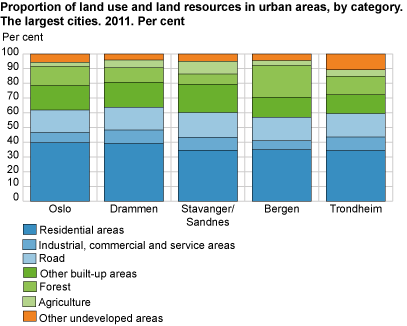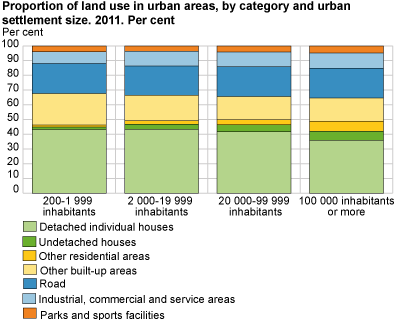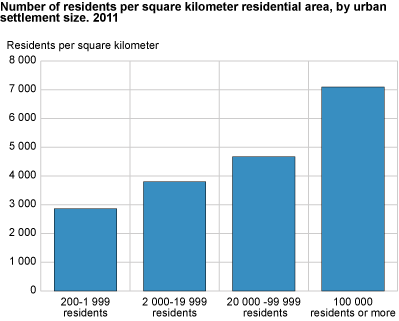Content
Published:
This is an archived release.
High share of residential areas
About one third of the urban areas in Norway are used as residential areas. Land used for roads covers 14 per cent, and areas used for business and administration services make up 7 per cent of the urban areas.
A new calculation of land use in Norway’s urban settlements shows that residential areas dominate the land use. In particular, detached individual houses take up much of the ground; about 85 per cent, while more densely developed residential areas comprise the last 15 per cent.
Land use in the largest cities
Among the largest urban settlements (with more than 100 000 inhabitants), Drammen has the largest share of built-up area, closely followed by Stavanger/Sandnes and Oslo. The built-up area comprises about 80 per cent of these urban settlements. The urban settlement of Bergen has the lowest share of built-up areas. Oslo and Drammen have the highest share of residential areas; close to 40 per cent. Drammen, Trondheim and Stavanger/Sandnes have the highest share of business and administration services.
Built-up areas by size of urban settlement
Urban settlements with less than 2 000 inhabitants have a lower share of residential areas than the larger urban settlements. The larger urban settlements have a lower share of detached individual houses area, while the share of densely developed residential areas is higher. Areas used for business and administration services, parks and sports facilities also increase with the size of the urban settlement. The share of urban areas used for roads is not dependent on the size; the share is about 20 per cent of the built-up area in all size groups.
Population within residential areas
The number of inhabitants within residential areas increases with the size of the urban settlement. Urban settlements with less than 2 000 inhabitants have slightly less than 3 000 inhabitants per square kilometre of residential area, while the number for the largest urban settlements is more than 7 000. In the smallest urban settlements, each inhabitant has about 350 square metres of residential area at their disposal, and in urban settlements with more than 100 000 inhabitants the corresponding figure is about 140 square metres.
The delimitation of urban settlements and land useThe method used for delimiting urban settlements gives a zone of undeveloped area at the edge of the urban settlements. This contributes to the high share of undeveloped areas within the urban settlements. Agricultural land and forest, and other undeveloped areas comprise about one third of the area of urban settlements. This undeveloped zone in particular accounts for a relatively large share of the smallest urban settlements. |
Contact
-
Margrete Steinnes
E-mail: margrete.steinnes@ssb.no
tel.: (+47) 95 73 55 54
-
Svein Johan Reid
E-mail: sjr@ssb.no
tel.: (+47) 41 51 29 66




